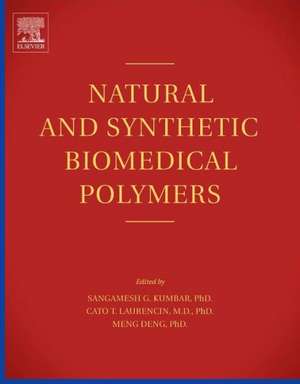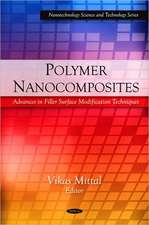Natural and Synthetic Biomedical Polymers
Editat de Sangamesh G. Kum bar, Cato Laurencin, Meng Dengen Limba Engleză Hardback – 20 ian 2014
Summarizing the main advances in biopolymer development of the last decades, this work systematically covers both the physical science and biomedical engineering of the multidisciplinary field. Coverage extends across synthesis, characterization, design consideration and biomedical applications. The work supports scientists researching the formulation of novel polymers with desirable physical, chemical, biological, biomechanical and degradation properties for specific targeted biomedical applications.
- Combines chemistry, biology and engineering for expert and appropriate integration of design and engineering of polymeric biomaterials
- Physical, chemical, biological, biomechanical and degradation properties alongside currently deployed clinical applications of specific biomaterials aids use as single source reference on field.
- 15+ case studies provides in-depth analysis of currently used polymeric biomaterials, aiding design considerations for the future
Preț: 540.89 lei
Preț vechi: 746.06 lei
-28% Nou
Puncte Express: 811
Preț estimativ în valută:
103.51€ • 107.41$ • 86.52£
103.51€ • 107.41$ • 86.52£
Carte tipărită la comandă
Livrare economică 10-24 martie
Preluare comenzi: 021 569.72.76
Specificații
ISBN-13: 9780123969835
ISBN-10: 0123969832
Pagini: 420
Ilustrații: 400 illustrations
Dimensiuni: 216 x 276 x 24 mm
Greutate: 1.17 kg
Editura: ELSEVIER SCIENCE
ISBN-10: 0123969832
Pagini: 420
Ilustrații: 400 illustrations
Dimensiuni: 216 x 276 x 24 mm
Greutate: 1.17 kg
Editura: ELSEVIER SCIENCE
Public țintă
Graduate biomaterials researchers and biomedical engineers with some medical device designers.Cuprins
Section 1. Synthesis and Characterization
1.1. Polymer Synthesis: the design and synthesis of important classes of polymeric biomaterials involving different monomers will be discussed.
1.2. Characterization of Polymeric Biomaterials: in vitro and in vivo characterization of advanced biomaterials, (cell and tissue interactions with polymeric biomaterials with various physico-chemical, mechanical properties, surface and degradation properties
Section 2. Currently Used Materials
2.1. Proteins and poly(amino acids) including collagen, poly(amino acids), elastin and elastin-like polypeptides, albumin, and fibrin
2.2. Polysaccharides including hyaluronic acid, chondroitin sulfate, chitin and chitosan, and alginic acid
2.3. Poly(α-ester)s including polylactides, polyglycolide, poly(lactide-co-glycolide), polycaprolactone, and bacterial polyesters
2.4. Polyurethanes
2.5. Poly(ester amide)
2.6. Poly(ortho esters)
2.7. Polyanhydrides
2.8. Poly(propylene fumarate)
2.9. Polyphosphazenes
2.10. Pseudo poly(amino acid)s
2.11. Polyphosphoester
2.12. Polyacetals
2.13. Poly(ethylene glycol)-based biomaterials
2.14. Dendrimers
2.15. Elastomers
Section 3. Biomedical Applications of Polymeric Biomaterials
3.1. Polymeric Biomaterials in Biomedical Implants
3.2. Polymeric Biomaterials in Drug Delivery
3.3. Polymeric Biomaterials in Tissue Engineering
3.4. Polymeric Biomaterials in Medical Diagnostics
1.1. Polymer Synthesis: the design and synthesis of important classes of polymeric biomaterials involving different monomers will be discussed.
1.2. Characterization of Polymeric Biomaterials: in vitro and in vivo characterization of advanced biomaterials, (cell and tissue interactions with polymeric biomaterials with various physico-chemical, mechanical properties, surface and degradation properties
Section 2. Currently Used Materials
2.1. Proteins and poly(amino acids) including collagen, poly(amino acids), elastin and elastin-like polypeptides, albumin, and fibrin
2.2. Polysaccharides including hyaluronic acid, chondroitin sulfate, chitin and chitosan, and alginic acid
2.3. Poly(α-ester)s including polylactides, polyglycolide, poly(lactide-co-glycolide), polycaprolactone, and bacterial polyesters
2.4. Polyurethanes
2.5. Poly(ester amide)
2.6. Poly(ortho esters)
2.7. Polyanhydrides
2.8. Poly(propylene fumarate)
2.9. Polyphosphazenes
2.10. Pseudo poly(amino acid)s
2.11. Polyphosphoester
2.12. Polyacetals
2.13. Poly(ethylene glycol)-based biomaterials
2.14. Dendrimers
2.15. Elastomers
Section 3. Biomedical Applications of Polymeric Biomaterials
3.1. Polymeric Biomaterials in Biomedical Implants
3.2. Polymeric Biomaterials in Drug Delivery
3.3. Polymeric Biomaterials in Tissue Engineering
3.4. Polymeric Biomaterials in Medical Diagnostics
Recenzii
"Overall, the book is of very great interest to a wide audience interacting with polymers, including chemists, biologists, and material scientists."--Biomat.net, July 2014
"Each chapter has a detailed table of contents. The text is generally well supported with figures and tables. Original literature is extensively cited. A useful index is provided. Overall, the book provides a concise introduction to biomedical polymers. It is hardbound and produced to a good quality."--Biotechnology Advances, 32, 2014
"Each chapter has a detailed table of contents. The text is generally well supported with figures and tables. Original literature is extensively cited. A useful index is provided. Overall, the book provides a concise introduction to biomedical polymers. It is hardbound and produced to a good quality."--Biotechnology Advances, 32, 2014














